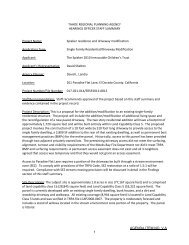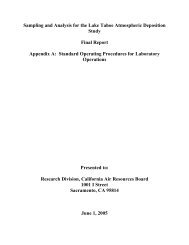FEIS - Tahoe Regional Planning Agency
FEIS - Tahoe Regional Planning Agency
FEIS - Tahoe Regional Planning Agency
You also want an ePaper? Increase the reach of your titles
YUMPU automatically turns print PDFs into web optimized ePapers that Google loves.
RESPONSE TO COMMENTS ON THE DEIS<br />
B o u l d e r B a y C o m m u n i t y E n h a n c e m e n t P r o g r a m P r o j e c t E I S<br />
Comment Letter 103 – Dahlgren Ph.D., Joy, 12/16/2009<br />
Comment 103-a: Comment Summary - Alt. C would increase trips and VMT because of additional<br />
workers and visitors to the site.<br />
Trip generation for Alternative C includes employees, guests, and non-guest visitors<br />
to the site. Please refer to Master Response 2, which compares the Proposed Project<br />
and Alternatives to an alternative existing baseline.<br />
Comment 103-b: Comment Summary - Alt. C trip generation estimates fail to consider external trips<br />
by guests to regional recreation, retail, and services beyond the Project Area.<br />
External project traffic estimates (vehicle trips in/out of the project area) include trips<br />
to the Project that are attracted to the onsite project amenities (non-guests) and trips<br />
to/from the proposed hotel/residential/interval ownership uses on the project area to<br />
other destinations (such as recreation, shopping, etc.). Master Response 3 provides<br />
additional clarification on internal/external Alternative mode trips. Master Response<br />
4 provides additional detail on project trip generation associated with accessory uses.<br />
Comment 103-c: Comment Summary - The EIS should disclose the base "Interacting Uses" numbers<br />
on which the "Internal Capture" numbers are based, and the interacting uses for the<br />
all "Raw Trips."<br />
Information on the interacting uses is provided in Appendix W of the DEIS. Master<br />
Response 3 provides additional clarification on internal/external Alternative mode<br />
trips including interacting uses.<br />
Comment 103-d: Comment Summary - The EIS should explain why Alt. C and A have different internal<br />
trip capture rates.<br />
Internal alternate mode rates, including on-site internal capture and off-site alternate<br />
modes, were developed specific to the type, size, and mix of the uses proposed for<br />
each Alternative. The number of internally captured walking trips between the<br />
project land uses was calculated by balancing the trips to correspond with the<br />
capacity of the lower trip generating use. Further explanation of the methodology<br />
used to calculate internal capture trips, as well as a visually representative figure, are<br />
provided in Master Response 3.<br />
Comment 103-e: Comment Summary - The trip generation numbers are incorrect. Trips were double<br />
counted when “Alternative Mode Split” factors were applied to the total number of<br />
“raw” trips, rather than only to external trips.<br />
The Alternative mode split and internal capture calculation were applied<br />
simultaneously to the raw project trips for each land use separately. There was not<br />
one percentage applied to the overall raw trip generation rate. The calculations were<br />
performed so that the internal/external alternate modes were analyzed based on<br />
specific land use type, size, and potential to interact with other on-site uses, off-site<br />
uses in close proximity, and transit opportunities. The Fehr & Peers Mixed Use<br />
Model and research looks at internally captured trips and off-site alternate mode trips<br />
as overall alternate modes because internal trips for mixed use sites are made via<br />
walking, bicycling, or transit depending on the size of the mixed use site. The model<br />
provides the overall “alternate modes” percentage for each use, which includes<br />
internal and external alternate modes, and a summary for the uses. The Fehr & Peers<br />
Mixed Use Model and research has been submitted to ITE, and will likely be<br />
included in future versions of the Trip Generation Handbook. The Fehr & Peers<br />
SEPTEMBER 8 , 2010 HAUGE BRUECK ASSOCIATES PAGE 8- 43






